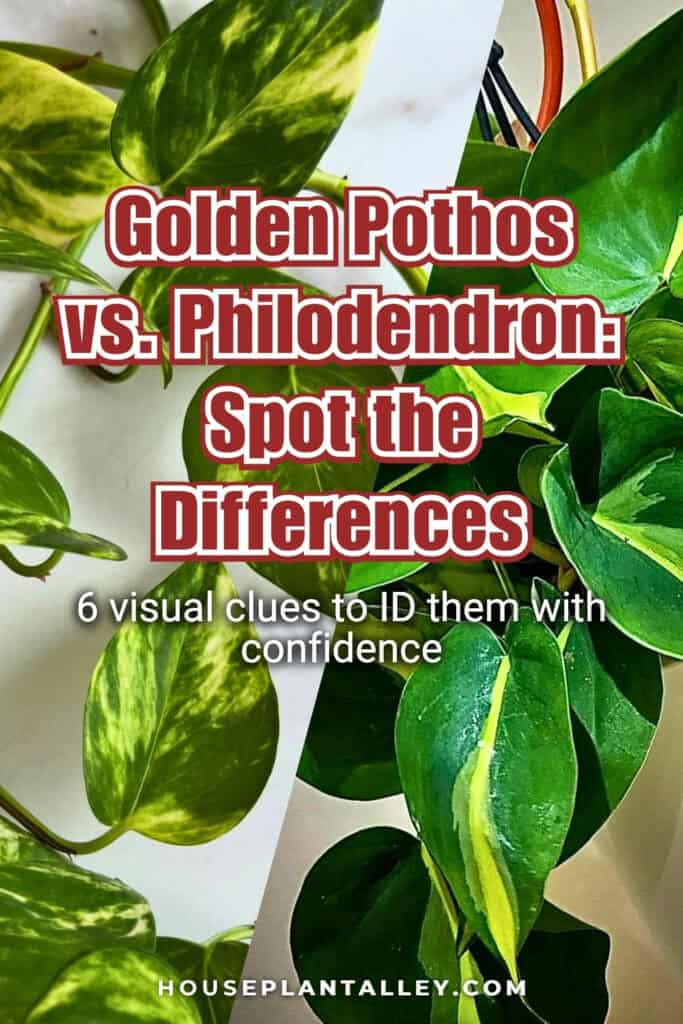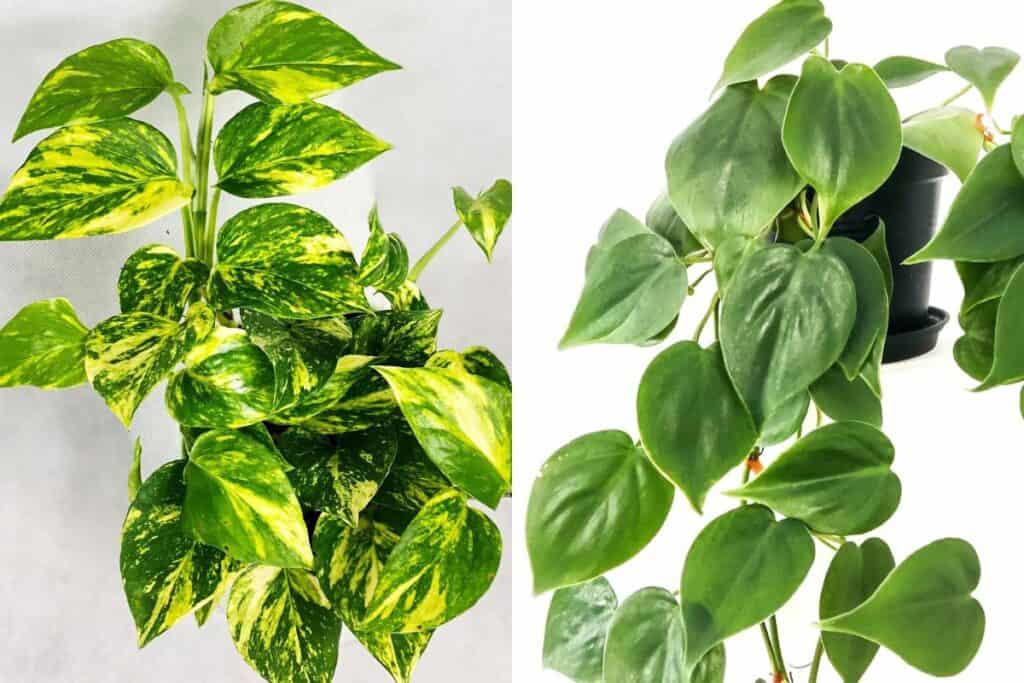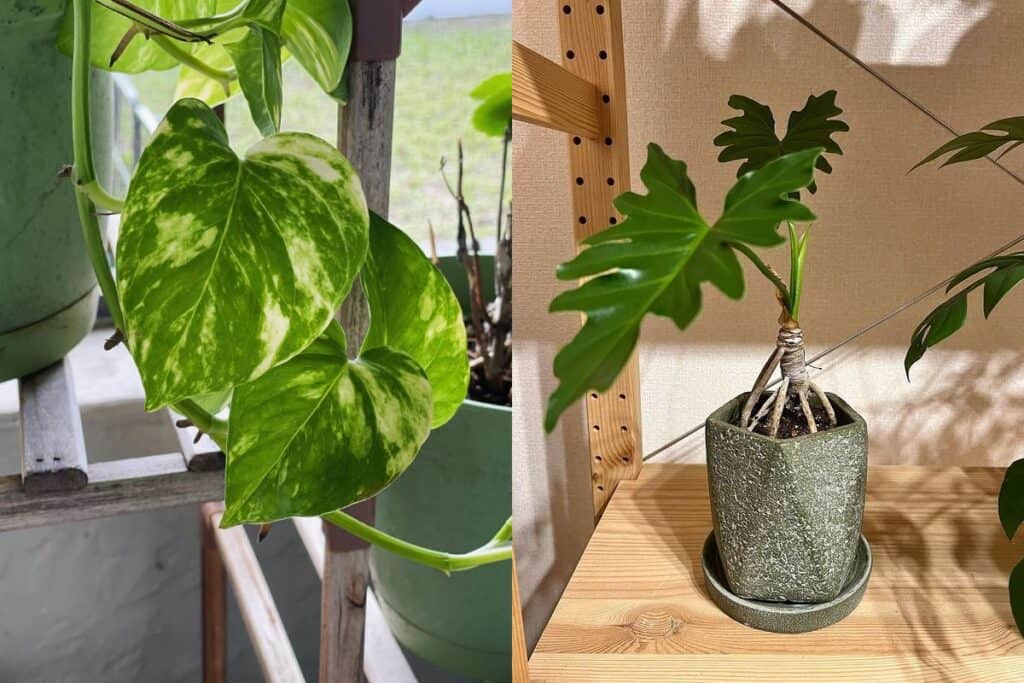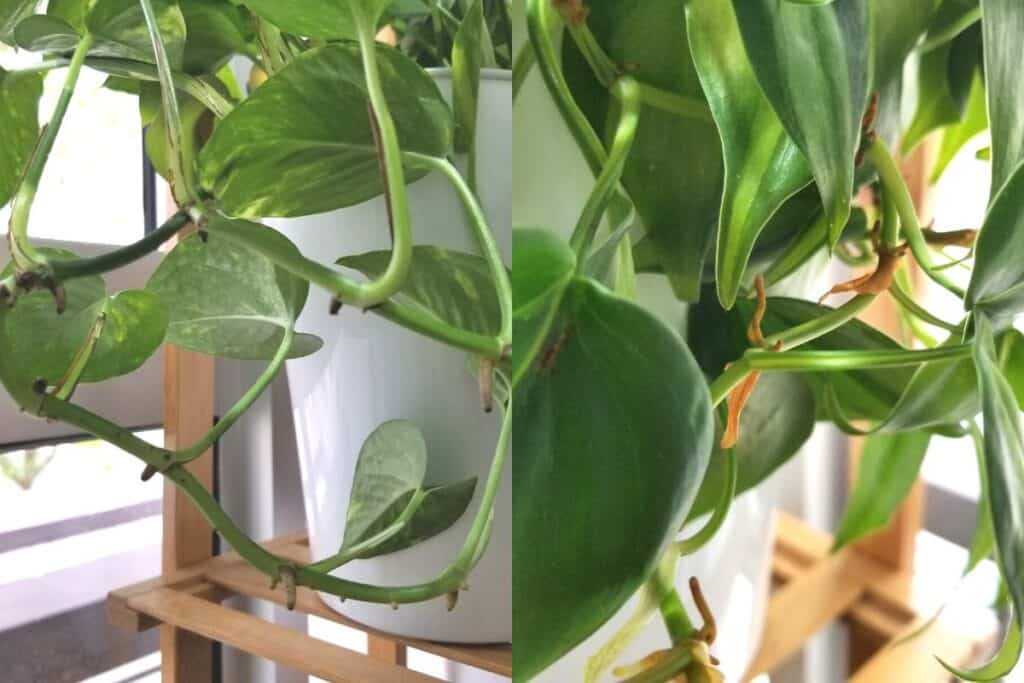Are you having trouble telling the difference between Golden Pothos and philodendron plants? If so, you’re not alone! While these two plants may look similar, there are some key distinctions that set them apart.
Knowing the difference between these two plants is important for the health of your garden. If you don’t know the difference, you may end up planting the wrong type of plant and not getting the results you were hoping for.
In this article, we’ll look at five ways to tell the difference between Golden Pothos and philodendron plants. We’ll also discuss the benefits and drawbacks of each to help you decide which one is right for your garden.

Contents
Golden Pothos Vs Philodendron
1. Taxonomy
Golden Pothos and philodendrons are two different plant species with different taxonomies.
Golden Pothos (Epipremnum aureum) is a species of flowering plant in the family Araceae. It is native to the Society Islands of Tahiti.
Philodendron is a large plant genus in the family Araceae, with many species found in the tropical Americas. Some common species of philodendron include Philodendron scandens (heartleaf philodendron), Philodendron bipinnatifidum (split-leaf philodendron), and Philodendron selloum (tree philodendron).

2. Aerial Roots
Aerial roots are roots that grow above the ground, rather than in soil. Both Golden Pothos and philodendrons can produce aerial roots, but they have some differences in their use and appearance.
Golden Pothos plants have thin, wiry aerial roots that grow along the stem of the plant. These roots help the plant to climb and anchor itself to surfaces.
Philodendron plants also produce aerial roots, but they are thicker and more robust than those of Golden Pothos. Some philodendron species, such as Philodendron scandens, have aerial roots that are used for climbing. Other species, such as Philodendron selloum, have aerial roots that grow down from the plant and take root in the soil, helping the plant to anchor itself and absorb nutrients.

Overall, the main difference between the aerial roots of Golden Pothos and philodendrons is their size and use. Golden Pothos roots are thin and used for climbing, while philodendron roots can be thicker and used for both climbing and anchoring the plant in the soil.
3. Petioles
The petiole is the stalk that connects a leaf to the stem of a plant. Both Golden Pothos and philodendrons have petioles, but they can differ in appearance and function.
Golden Pothos has thin, flexible petioles that allow the leaves to move and drape gracefully. The petioles are typically green in color.
Philodendron petioles can vary depending on the species, but some common characteristics include:
- Thickness: Some philodendron species, such as Philodendron scandens, have thin petioles similar to those of Golden Pothos. Others, such as Philodendron bipinnatifidum, have thicker petioles that can be almost as wide as the leaf blade.
- Color: Philodendron petioles can be green, reddish, or purplish in color, depending on the species and growing conditions.
- Function: In some philodendron species, such as Philodendron selloum, the petioles are modified to form sheaths that enclose the stem and protect it from herbivores. In other species, the petioles may have small spines or ridges that help the plant climb.
By distinguishing the petioles, you can easily transition into the next factor in telling them apart: leaf texture and shape.
4. Leaf Texture And Shape
Golden Pothos and philodendrons are both known for their attractive foliage, and their leaves can differ in texture and shape.
Golden Pothos has smooth, glossy leaves that are variegated with yellow and green coloring. The leaves are typically oval or heart-shaped and have a wavy margin.
Philodendron leaves can vary depending on the species, but some common characteristics include:
- Texture: Some philodendron species, such as Philodendron scandens, have smooth, glossy leaves similar to those of Golden Pothos. Others, such as Philodendron bipinnatifidum, have more matte or leathery leaves.
- Shape: Philodendron leaves can be oval, heart-shaped, or lobed, depending on the species. Some species, such as Philodendron selloum, have large, deeply lobed leaves. Others, such as Philodendron bipinnatifidum, have smaller, more finely divided leaves.
To continue investigating the differences between the two plants, we move on to the sheath.
5. Sheath
One of the most striking differences between Golden Pothos and philodendrons is the presence of a sheath, which is a protective layer that covers the stem of each leaf. While the philodendron has a sheath that is very distinct and easily visible, Golden Pothos leaves have no sheath at all. This makes it easy to tell the two plants apart at a glance.

Philodendron species can have sheaths, depending on the species. For example, Philodendron selloum has large, petiole-like sheaths that enclose the stem and protect it from herbivores. Other species, such as Philodendron bipinnatifidum, do not have sheaths.
6. Flowers
Golden Pothos and philodendrons are both flowering plants, but they have different types of flowers.
Golden Pothos has small, greenish-yellow flowers that grow on a spadix (a type of flower spike) surrounded by a spathe (a large bract or leaf-like structure). The flowers are not particularly showy and are not the main attraction of the plant.
Philodendron flowers are also small and not showy, with petals that are greenish, yellow, or brown in color. They are borne on a spadix, similar to Golden Pothos.
Both plants reproduce primarily through vegetative means, such as producing offsets or stem cuttings, rather than producing seeds. This means that their flowers are not necessary for the plant to reproduce.
With this in mind, we can move on to the next part of our article, which focuses on how to care for Golden Pothos and philodendrons.
Golden Pothos vs Philodendron Care Tips
When it comes to caring for Golden Pothos and philodendrons, the key is to keep it simple. While they may appear similar at first glance, they have different needs when it comes to light, humidity, and watering.
To ensure that your plants stay healthy and vibrant, treat them like old friends—give them love, attention, and a bit of TLC.
When it comes to light, both plants prefer bright, indirect light, but philodendrons can tolerate low-light conditions better than Golden Pothos. In terms of humidity, philodendron prefers higher levels of moisture, whereas Golden Pothos can tolerate drier air.
As for watering, both plants enjoy moist soil, but philodendron needs a bit more than Golden Pothos. With a little bit of practice, you’ll be able to tell when it’s time to water by simply looking at the leaves.
By following these simple tips, you’ll be able to keep your Golden Pothos and philodendron happy and healthy.
Frequently Asked Questions
How Do I Identify A Philodendron?
Identifying a philodendron is like discerning a leafy work of art – each one is unique and different from the next.
There are many species of philodendron, and they can vary in appearance depending on the specific species and growing conditions. Here are some characteristics that can help you to identify a philodendron plant:
- Leaves: Philodendron leaves are typically large and glossy, with various shapes and lobing patterns depending on the species. Some common leaf shapes include oval, heart-shaped, and lobed.
- Stems: Philodendron stems are typically thick and succulent, and they may have aerial roots that help the plant to climb.
- Flowers: Philodendron flowers are small and not showy, with petals that are greenish, yellow, or brown in color. They grow on a spadix, which is a type of flower spike.
How Can You Tell A Golden Pothos?
Golden Pothos (Epipremnum aureum) is a popular houseplant known for its attractive variegated leaves and easy care. Here are some characteristics that can help you to identify a Golden Pothos plant:
- Leaves: Golden Pothos has large, glossy leaves that are variegated with yellow and green coloring. The leaves are typically oval or heart-shaped and have a wavy margin.
- Stems: Golden Pothos has thin, flexible stems that allow the plant to trail or climb.
- Flowers: Golden Pothos has small, greenish-yellow flowers that grow on a spadix (a type of flower spike) surrounded by a spathe (a large bract or leaf-like structure). The flowers are not particularly showy and are not the main attraction of the plant.
- Native habitat: Golden Pothos is native to the Society Islands of Tahiti and is often grown as a houseplant or outdoor groundcover in tropical and subtropical regions.
- Care requirements: Golden Pothos is relatively easy to care for and can tolerate a wide range of growing conditions. It prefers well-draining soil and should be watered regularly, but not allowed to sit in standing water.
Is Golden Pothos The Same As Philodendron Birkin?
No, Golden Pothos (Epipremnum aureum) and Philodendron Birkin are two different plant species.
Golden Pothos is a trailing plant with variegated leaves that have yellow and green coloring. It is native to the Society Islands of Tahiti and is often grown as a houseplant or outdoor groundcover in tropical and subtropical regions.
Philodendron Birkin is a newer cultivar of Philodendron that was introduced in 2018. It is a small, compact plant with dark green, glossy leaves that are heart-shaped and have a wavy margin. It is also grown as a houseplant and is known for its easy care and tolerance of a wide range of growing conditions.
How Do I Know If I Have A Philodendron Or Pothos?
The first step in knowing if you have a philodendron or a pothos is to examine the leaves. Philodendron leaves are typically darker green, elliptical in shape with smooth edges, and larger than pothos leaves. Pothos leaves are typically lighter green, heart-shaped, and smaller than philodendron leaves.
Another way to tell the difference between a philodendron and a pothos is by looking at the stems. Philodendron stems are typically thicker and have a reddish-brown color. Pothos stems are thinner and are usually green.
Finally, another key difference between the two plants is the way they grow. Philodendrons are generally more vining and will tend to grow up and over things. Pothos, on the other hand, are bushy and will tend to spread outwards.
Conclusion
When it comes to identifying the difference between a Golden Pothos and a philodendron, it is important to look closely at the leaves and the stems of each plant. Both plants share similar features, such as heart-shaped leaves, but the size and shape of the leaves and stems can be different. Additionally, the color of the leaves and the texture of the stem can provide clues as to which plant you are looking at.
